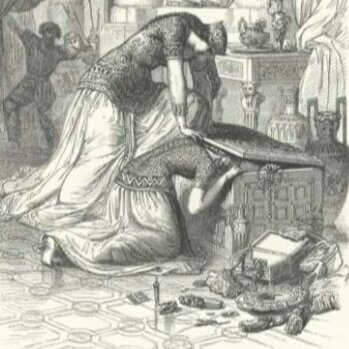On brand for me: Poldark
I’m an unabashed word nerd and history lover. PBS-Masterpiece-watching, Scrabble-playing, historical-photos-instagram-account-following multipotentialite (look it up). Guilty as charged. I also love writing for kids. So it’s not surprising that all these coalesced into my new book THE GREAT AND THE TERRIBLE: The World's Most Glorious and Notorious Rulers and How They Got Their Names (Running Press Kids).
My idea for THE GREAT AND THE TERRIBLE started with a simple premise. I’d look for rulers throughout history who were remembered by a single adjective—a nickname, a sobriquet, a cognomen, a posthumous name. It seemed like such an elegant way to be remembered—one word to sum up a whole life, a life, a portfolio of accomplishments. Was it possible that a single word could capture it all? What would be lost in the process?
Catherine the Great: Making a comeback
The sobriquets GREAT and TERRIBLE were the starting point. There were no shortage of ‘greats’ to choose from, people I’d never heard of before. Sargon the Great? Canute the Great? At the top of the list of terrible was the name we’ve all probably heard: Ivan. Then there’s his countrywoman Catherine the Great
I was off down the delightful research rabbit hole, unearthing hidden histories, like that of Roman emperor Heliogabalus, referred to by at least one historian as Heliogabalus the Horrible for his wicked deeds, such as (allegedly) suffocating his guests by releasing onto them a raft of rose petals so weighty that it cut off their oxygen supply. Or Fredegund the Bloodthirsty, a Merovingian (pre-French) queen who killed her own daughter by luring her to a trunk of jewels and then snapping the lid down on her neck!
The Roses of Heliogabalus by Lawrence Alma-Tadema, 1888
A terrible mother: Fredegund the Bloodthirsty
But history isn’t just littered with baddies. There were previously unknown-to-me acts of greatness, such as those by Taksin the Great, king of Thonburi, in the area that is now Bangkok, known both as a great warrior and a champion of the arts and education. And Hatshepsut, the great ‘female pharaoh,’ whose jealous successor tried to have her erased from history. Then there were also a lot of leaders who are remembered only with regrettable or sometimes just humorous nicknames: Italo the Cabbage, Pippen the Short, Alfonso the Slobberer.
The remarkable Nanyehi, Cherokee Ghigau or “Beloved Woman.”
As I dug deeper, I discovered how many gaps there are in the history that most of us learn, the rich and interconnected nature of cultures from around the world. The extraordinary number of women with incredible accomplishments who have been overlooked, one just miles from my own home! (Nanyehi, the “Beloved Woman” of the Cherokee). In THE GREAT AND THE TERRIBLE, I hope to shine the light on them.
I first came up with the idea for THE GREAT AND THE TERRIBLE over 10 years ago. I saved one of the rejections I got when this book was sent out at the time. The editor said she didn’t think kids wanted to read about ‘a bunch of foreign rulers with hard-to-pronounce names.’ Times have changed and I hope kids want to explore the rich tapestry of leaders who made history because of their deeds. I’m looking forward to introducing them!















